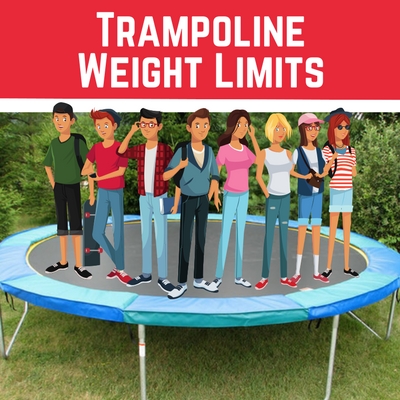Jumping on a Trampoline While Pregnant
As a pregnant woman, you may be wondering if it is safe to jump on a trampoline. The answer is that it depends on how far along you are in your pregnancy and whether or not you have any risk factors for complications. If you are healthy and have no risk factors, jumping on a trampoline is generally considered safe.
However, if you are early in your pregnancy or have any medical conditions that could complicate your pregnancy, it is best to avoid jumping on a trampoline.
Jumping on a trampoline while pregnant is a great way to get some exercise and have some fun! However, there are a few things you should keep in mind. First, make sure the trampoline is in good condition and has no sharp edges.
Second, jump gently – don’t try any fancy flips or other tricks. Third, listen to your body – if you start to feel tired or uncomfortable, stop jumping and rest. And finally, be sure to talk to your doctor before starting any new exercise routine during pregnancy.
Is It Safe to Jump on a Trampoline While Pregnant
There is no definitive answer to this question as it depends on a number of factors. If you are pregnant and considering jumping on a trampoline, you should speak to your doctor first. They will be able to advise you on whether or not it is safe for you, based on your individual circumstances.
Generally speaking, jumping on a trampoline is not considered safe during pregnancy. This is because there is a risk of falling and injuring yourself, or causing harm to the baby. The American College of Obstetricians and Gynecologists (ACOG) does not recommend trampoline use during pregnancy.
That being said, if you have been cleared by your doctor and feel comfortable doing so, there is no reason why you can’t jump on a trampoline while pregnant. Just be sure to take things slowly at first and listen to your body. If you start to feel dizzy or lightheaded, stop immediately and rest.
What are the Benefits of Jumping on a Trampoline While Pregnant
The benefits of jumping on a trampoline while pregnant are many. For one, it can help improve your balance and coordination. Additionally, it can increase the strength of your muscles and bones, as well as improve your circulation.
Furthermore, jumping on a trampoline can also help to reduce stress levels and promote relaxation.
Are There Any Risks Associated With Jumping on a Trampoline While Pregnant
Yes, there are risks associated with jumping on a trampoline while pregnant. The main concern is the risk of falling, which can cause serious injury to both mother and baby. Additionally, the bouncing motion can put unnecessary strain on the back and joints, which can lead to pain or discomfort.
If you are pregnant and considering jumping on a trampoline, be sure to speak with your doctor first to weigh the risks and benefits.

Credit: plexhiwire.com
Can You Jump on a Trampoline While Pregnant 2Nd Trimester
Trampolines are a fun way to stay active during pregnancy, but there are some things to keep in mind before you start bouncing around. First and foremost, always check with your doctor before starting or continuing any exercise regimen during pregnancy.
In general, trampolining is considered safe for pregnant women, as long as you take some precautions.
Avoid jumping too high or doing any flips or other acrobatic moves that could put unnecessary stress on your body. It’s also important to wear proper footwear and use a trampoline with a safety net.
If you have any concerns about whether trampolining is right for you, talk to your doctor or midwife.
They can help you make the best decision for you and your baby’s health.
Can You Jump on a Trampoline While Pregnant to Induce Labor
If you’re like most people, you probably think that trampolines are only for kids. But did you know that jumping on a trampoline can actually help to induce labor?
It may sound crazy, but it’s true!
The bouncing motion of the trampoline can help to encourage the baby to move down into the birth canal and also help to break up any remaining amniotic fluid.
Of course, you should always check with your doctor before trying this method, as it is not suitable for everyone. If you have any concerns or medical conditions, it’s best to err on the side of caution and avoid using a trampoline during pregnancy.
Can You Jump on a Trampoline While Pregnant 3Rd Trimester
Yes, you can jump on a trampoline while pregnant third trimester. However, there are certain precautions you need to take in order to ensure a safe and healthy experience for both you and your baby. First, make sure that the trampoline is in good condition and that the mat is properly secured.
Second, avoid jumping too high or doing any flips or other stunts. Third, wear comfortable clothing that supports your growing belly. Finally, listen to your body and stop if you feel tired or uncomfortable at any point.
Can You Jump on a Trampoline While 5 Weeks Pregnant
If you’re wondering whether it’s safe to jump on a trampoline while you’re pregnant, the answer is generally yes – as long as you take some precautions. First, make sure the trampoline is in good condition and has no rips or tears in the mat. Second, avoid doing any flips or other high-impact moves that could put stress on your belly.
And finally, listen to your body – if jumping starts to feel uncomfortable, take a break.
Assuming you follow these guidelines, jumping on a trampoline can actually be great exercise during pregnancy. It helps build strength and stamina, and can help improve your balance (which can come in handy when you’re lugging around a growing baby!).
Just be sure to talk to your doctor before starting any new exercise routine during pregnancy.
Can You Jump on a Trampoline While 10 Weeks Pregnant
Yes, you can jump on a trampoline while 10 weeks pregnant. However, you should consult with your healthcare provider first. Trampolining is a relatively low-impact activity, but there are still some risks to consider.
For example, jumping could cause the uterine lining to separate from the placenta, which could lead to a miscarriage. Additionally, the bouncing motions could put stress on the cervix and potentially cause premature labor.
That being said, as long as you listen to your body and don’t do anything too strenuous, trampolining can be a fun way to stay active during pregnancy.
Just be sure to wear proper footwear and use caution when getting on and off the trampoline.
Can You Jump on a Trampoline While 13 Weeks Pregnant
Yes, you can jump on a trampoline while 13 weeks pregnant. You should however take some precautions to make sure that you don’t injure yourself or your baby. First, avoid jumps that are too high or bouncy.
Second, land with your knees bent to absorb the impact. Third, use a trampoline with a good safety rating and never bounce alone. Finally, listen to your body and stop if you feel any pain or discomfort.
Can Jumping on Trampoline Cause Miscarriage
The trampoline is a great way to stay fit during pregnancy, but you may be wondering if it’s safe. Can jumping on a trampoline cause miscarriage?
There is no definitive answer, as there is no scientific evidence to support or refute this claim.
However, it is generally considered safe for pregnant women to jump on a trampoline, as long as they take some precautions.
First and foremost, always consult with your doctor before starting any new exercise regimen during pregnancy. Once you have the green light from your OBGYN, start slowly and listen to your body.
If you feel any pain or discomfort, stop immediately.
In general, it’s best to avoid high-impact activities like running or jumping during pregnancy. However, bouncing on a trampoline can actually provide some low-impact cardio benefits.
Just be sure to not overdo it – 10 minutes of bouncing should suffice. And be sure to wear supportive shoes and clothing.
As long as you take some basic precautions, jumping on a trampoline can actually be a fun and safe way to stay active during pregnancy!
Can You Jump on a Trampoline While 9 Weeks Pregnant
For many women, pregnancy is a time of joy and excitement. But it can also be a time of uncertainty, especially when it comes to exercise. So, can you jump on a trampoline while 9 weeks pregnant?
The short answer is yes, but with some caveats. First and foremost, you should check with your doctor or midwife to make sure that jumping on a trampoline is safe for you and your baby. If they give you the green light, then go ahead and enjoy yourself!
Just be sure to listen to your body and stop if you feel any pain or discomfort.
Second, jumping on a trampoline during pregnancy can actually be good for you! It’s great exercise that can help improve your cardiovascular health and strengthen your muscles.
Plus, it can help relieve stress and promote better sleep (something that can be hard to come by during pregnancy).
So if you’re looking for a fun way to stay active during pregnancy, put on your sneakers and get bouncing on a trampoline!
Conclusion
A woman who is pregnant may worry about whether it is safe to jump on a trampoline. There is no definitive answer, as each pregnancy is different. However, jumping on a trampoline while pregnant may not be the best idea.
The added impact and jostling could potentially be harmful to the baby. If a woman does choose to jump on a trampoline while pregnant, she should do so with caution and consult her doctor first.
What is the Weight Limit on a Trampoline
There are many factors to consider when purchasing a trampoline. One of the most important considerations is the weight limit. The weight limit will determine how much weight the trampoline can safely support.
Most trampolines have a weight limit of 250 pounds. This means that the trampoline can safely support up to 250 pounds of weight.
There is no definitive answer to this question as it depends on the make and model of the trampoline, as well as the weight and height of the user. However, a good rule of thumb is that the weight limit for a standard round trampoline is approximately 250 lbs.
If you’re looking for a trampoline that can accommodate more weight, there are some models on the market specifically designed for heavier users.
These trampolines typically have a weight limit of 350 lbs or more.
When choosing a trampoline, it’s important to consider not only the weight limit but also the height limit. This is because taller users will put more stress on the frame and springs, which could lead to breakage if they exceed the recommended weight limit.
As always, when using any type of exercise equipment it’s important to follow all safety guidelines in order to avoid injury. This means making sure that everyone using the trampoline is within the recommended height and weight limits. With proper care and use, a trampoline can provide hours of fun and exercise for people of all ages!
Can You Be Too Heavy for a Trampoline?
Yes, you can be too heavy for a trampoline. The weight limit for most trampolines is 250 pounds. If you weigh more than that, the trampoline will not be able to support your weight and you could end up injured.
What is the Weight Limit for a 14 Foot Trampoline?
The weight limit for a 14 foot trampoline is 250 pounds.
How Much Weight Can a 10Ft Trampoline Hold?
A 10ft trampoline can hold up to 250lbs.

Credit: www.gettrampoline.com
How Much Weight Can a Trampoline Hold in Kg
A trampoline can hold a lot of weight, but it all depends on the size and type of trampoline. For example, a mini trampoline might only be able to hold 50 kg or less, while a full-size Olympic trampoline could hold over 200 kg. It’s important to check the weight limit before purchasing or using a trampoline.
What Happens If You Exceed the Weight Limit on a Trampoline
If you exceed the weight limit on a trampoline, it is possible that the frame may break. This would cause the springs to fly out, which could result in serious injury. It is also possible that the mat could tear, which would also lead to injuries.
Trampoline Weight Limit 500
If you’re in the market for a trampoline, one of the things you’ll need to consider is the weight limit. Most trampolines have a weight limit of 250-300 pounds, but there are some that can accommodate up to 500 pounds.
When deciding on a trampoline, it’s important to consider how many people will be using it and their approximate weights.
If you have a family of four with two adults and two children, a 250-pound weight limit may not be enough. In this case, opting for a trampoline with a higher weight limit would be wise.
Another thing to keep in mind is that the weight limit includes not only people but also any additional weight from things like blankets or pillows.
So if you plan on using your trampoline for lounging as well as bouncing, keep this in mind when choosing which model to buy.
No matter what weight limit you choose, always make sure everyone using the trampoline is aware of it and abides by it. This will help prevent accidents and injuries.
How to Increase Weight Limit on Trampoline
If you’re looking for ways to increase the weight limit on your trampoline, there are a few things you can do. First, check with the manufacturer to see if there are any upgrades or modifications that can be made to your trampoline. Often times, manufacturers will offer weight limit increases as an upgrade.
Another option is to reinforce your trampoline’s frame. This can be done by adding additional supports or cross-bracing to the frame. This will help to distribute weight more evenly and may allow you to increase the weight limit on your trampoline.
Finally, make sure that everyone who uses the trampoline knows the new weight limit and abides by it. By following these tips, you can help ensure that your trampoline remains safe and enjoyable for years to come!
What is the Weight Limit on a 14Ft Trampoline
There is no definitive answer to this question as it depends on the manufacturer and model of trampoline. However, most 14ft trampolines have a weight limit of around 250lbs. This means that they can safely accommodate 1-2 people at a time.
Of course, it is always best to check the weight limit of your specific trampoline before use.
15 Foot Trampoline Weight Limit
There are many factors to consider when purchasing a trampoline. One of the most important considerations is the weight limit. Most 15 foot trampolines have a weight limit of 250-300 lbs.
If you plan on using your trampoline for acrobatic tricks or flips, you will need to purchase one with a higher weight limit. Some companies offer special “acrobatic” models that can accommodate up to 400 lbs.
When choosing a trampoline, be sure to select one that is age and weight appropriate for all users.
It is also important to follow all manufacturer’s safety guidelines regarding use and maintenance of the trampoline.
12 Foot Trampoline Weight Limit
In general, a 12 foot trampoline will have a weight limit of around 300 pounds. This means that the maximum weight that the trampoline can safely support is 300 pounds. However, it is important to note that this weight limit may vary depending on the specific model of trampoline and the manufacturer.
Always be sure to check the weight limit for your particular trampoline before allowing anyone to use it.
Now that you know the average weight limit for a 12 foot trampoline, you may be wondering how this compares to other sizes of trampolines. In general, larger trampolines will have higher weight limits than smaller ones.
For example, a 14 foot trampoline typically has a weight limit of 350 pounds, while a 16 footer usually has a 400 pound weight limit. So if you’re looking for a trampoline that can accommodate heavier users, you’ll want to go with a larger size.
Of course, even with the highest weight limits, it’s still important to use caution when jumping on any size of trampoline.
If multiple people are using the sametr ampoline at once, be sure not to exceed the total combined weight limit. Also, keep in mind that bouncing too high or landing incorrectly can lead to injuries regardless of how much someone weighs. So always exercise caution and use good judgement when using any type oftr ampoline!
8Ft Trampoline Weight Limit
When you purchase a trampoline, one of the key considerations is the weight limit. This is especially important if you have multiple people using the trampoline at the same time. The 8ft trampoline weight limit is typically 250-300 lbs.
However, there are some 8ft trampolines that have a higher weight limit of 350 lbs. It is important to check the weight limit before purchasing an 8ft trampoline to make sure it will accommodate everyone who plans to use it.
Conclusion
Most trampolines have a weight limit of around 200-250 pounds. This is because the frame and mat of a trampoline need to be able to support the weight of the jumper without breaking. If you are over the weight limit for your trampoline, it is important to take extra care when jumping to avoid putting too much strain on the frame and mat.
How to Keep a Trampoline from Blowing Away
A trampoline can provide hours of fun for kids and adults alike, but if not anchored properly, it can blow away in strong winds. To keep your trampoline from blowing away, follow these simple tips. First, make sure to choose a location for your trampoline that is sheltered from strong winds.
If possible, place it against a fence or wall. You can also use sandbags or water-filled jugs to weigh down the corners of the trampoline. Be sure to secure the weights so they don’t blow away as well!
Finally, check your trampoline regularly to make sure all the anchor points are secure and there are no gaps that could allow wind to get underneath and lift the trampoline up.
- Purchase a trampoline with a weight limit that exceeds the expected wind speed in your area
- Place the trampoline on level ground in an open area away from trees, buildings, or other objects that could provide wind shelter
- Secure the trampoline to the ground using either stakes driven through the loops at the end of each leg, or by attaching it to weights placed on each corner (such as cinder blocks)
- If strong winds are forecast and you cannot stake or weigh down your trampoline, remove it from use and store it in a safe location until the storm has passed
Will Sandbags Hold down a Trampoline?
No, sandbags will not hold down a trampoline. The weight of the sandbags will cause the trampoline to sink into the ground, making it unstable and unsafe to use.
How Much Wind Will Lift a Trampoline?
A trampoline can be lifted by the wind if it is not properly secured. If the trampoline is not properly weighted down, then the wind can pick it up and carry it away. The amount of wind required to lift a trampoline depends on the size and weight of the trampoline.
How Do You Secure a Trampoline in a Windstorm?
If you live in an area with high winds, it’s important to take measures to secure your trampoline. Otherwise, strong gusts of wind can cause the trampoline to tip over or blow away entirely. Here are some tips for securing a trampoline in a windstorm:
1. Anchor the trampoline to the ground using stakes or sandbags. This will help keep it in place during high winds.
2. If possible, move the trampoline into a sheltered area such as a garage or shed.
This will further protect it from strong winds.
3. Remove any loose items from around the trampoline that could be blown away by the wind and become dangerous projectiles (e.g., lawn chairs, toys, etc.).
4. Make sure everyone is off of the trampoline before the storm hits.
It’s not worth risking injury for a few minutes of fun on the trampoline during bad weather!
How Do You Anchor a Trampoline for Wind?
When you purchase a trampoline, it will come with anchor kits. If your trampoline did not come with anchors, you can purchase them at most hardware stores. Before installing the anchors, measure the height of your trampoline from the ground to the top of the frame.
Most importantly, check the wind rating for your particulartrampoline model and weight capacity to be sure that it is rated for high winds in your area
There are four different ways that you can secure a trampoline for windy conditions: bury the legs, use weights on all legs, tie down the entire perimeter or remove completely and store indoors when not in use.
Bury The Legs: This is probably the most effective way to secure a trampoline for windy conditions because it involves putting each leg of the trampoline into its own hole that has been properly filled with sand or cement.
Once each leg is buried about two feet deep, fill in around each leg until level with ground surface and pack down firmly so that no air pockets remain. This will give added stability to keep your anchoredtrampoline from blowing away
Weights On All Legs: If burying legs is not an option due to lack of space or rocks in soil, another option is to use weights on all legs.
You can use buckets filled with sand or cement, cinder blocks or even large rocks placed on top of each foot plate where each leg meets the frame. For extra security during high winds tie a rope around perimeter of weighted down trampoline and stake into ground
Tie Down Entire Perimeter: Another way to help keep your anchoredtrampoline from blowing away during high winds is by tying down the entire perimeter using either ropes or bungee cords looped through holes located around outside edge of matting material and staked securely into ground

Credit: www.whatkids.co.uk
How Much Weight to Hold down a Trampoline
Most trampolines come with a weight limit, and it’s important to know how much weight your trampoline can hold before adding any additional weight. While you might be tempted to add more people or objects to your trampoline for extra fun, doing so could cause the trampoline to break or collapse, leading to serious injury.
As a general rule of thumb, each person or object on a trampoline should weigh no more than 100 pounds.
This includes children and adults alike. If you have a large trampoline that can accommodate more weight, then you can increase the limit accordingly. Just be sure not to exceed the manufacturer’s recommended weight limit for your specific model.
When determining how many people or objects can safely be on your trampoline at one time, also consider the combined weight of everyone or everything involved. For example, two adults who weigh 150 pounds each would exceed the 100-pound weight limit if they were both on the same small trampoline together. However, two adults who each weigh 150 pounds could safely use a large trampoline together since their combined weight would be 300 pounds which is well within most manufacturers’ limits for large models.
In short, use common sense when adding weight to your trampoline and always err on the side of caution by sticking to lower weights whenever possible. By following these guidelines, you can help ensure that everyone enjoys using your trampoline safely without putting too much strain on the equipment.
Trampoline Tie down Kit
A trampoline tie down kit is a set of straps and buckles that are used to secure a trampoline to the ground. These kits are available for both in-ground and above-ground trampolines, and typically include four to six straps that attach to the legs of the trampoline. The kits also usually come with a ratchet or cam buckle, which is used to tighten the straps.
There are several reasons why you might want to use a tie down kit on your trampoline. First, it can help prevent the trampoline from being blown away by strong winds. Second, it can keep the trampoline from moving around if it’s placed on an uneven surface.
And finally, tying down your trampoline can also help deter thieves from stealing it!
If you’re interested in purchasing a trampoline tie down kit, they are widely available online and at most retail stores that sell trampolines. Prices will vary depending on the quality of the materials used and how many straps are included in the kit, but you can expect to spend around $30-$50 for a good quality set.
Turn Trampoline Upside down
Most people don’t know that you can actually turn a trampoline upside down. Doing so gives you a whole new perspective on jumping, and opens up a world of new tricks and flips that you can do. It’s not as easy as it sounds though, and you’ll need to follow some specific instructions to get it done safely.
Here’s how to turn your trampoline upside down:
1. First, remove all the pads and other accessories from your trampoline. You don’t want anything getting in the way when you’re flipping it over.
2. Next, take off the spring cover by unscrewing the bolts that hold it in place. Be careful not to lose any of the springs!
3. Now it’s time to flip the frame over.
You’ll need at least two people for this part – one person on each side of the frame. Slowly lift the frame and flip it over so that it’s resting on its top rail.
4. Once the frame is flipped, put the spring cover back on and screw it into place.
Then re-attach all of the pads and other accessories.
How to Weigh down a Trampoline on Concrete
If you have a trampoline that you need to weigh down on concrete, there are a few things that you can do. You will need some heavy objects to put on the trampoline so that it does not move around. You can use cinder blocks, sandbags, or any other type of heavy object.
Make sure that whatever you use is safe and will not damage the trampoline.
You will also need to secure the trampoline to the ground. You can do this with either straps or ropes.
Make sure that the straps or ropes are tight so that the trampoline does not move around.
Once you have everything in place, you should test it out to make sure that it is secure and will not move around. This is especially important if you have young children who will be using the trampoline.
Best Trampoline Anchors for High Wind
When it comes to choosing the best trampoline anchors for high wind, you have a few options. You can either go with traditional metal ground stakes, or you can opt for something a little more heavy-duty like hurricane straps.
If you live in an area that experiences high winds on a regular basis, then hurricane straps are definitely the way to go.
These straps are designed to hold down trampolines in even the strongest of winds. They’re easy to install and remove, and they’ll keep your trampoline firmly in place no matter what Mother Nature throws at it.
Metal ground stakes are another option for anchoring your trampoline in high winds.
These stakes are driven into the ground, and then the trampoline is secured to them using ropes or bungee cords. This method is effective, but it can be a bit time-consuming to set up and take down each time the wind picks up.
No matter which type of anchor you choose, make sure that you use enough of them to keep your trampoline safe and secure in high winds.
Also, be sure to check your anchors regularly to make sure they’re still doing their job – especially if you live in an area where hurricanes are common!
How to Secure a Trampoline Without Stakes
Most trampolines come with stakes that are used to secure the trampoline to the ground. However, if you do not have stakes or if you want to use the trampoline without stakes, there are a few things that you can do to keep it secure.
First, make sure that the area around the trampoline is clear of any debris or objects that could cause the trampoline to tip over.
Second, weight down the legs of the trampoline by placing sandbags or heavy objects on top of them. This will help to keep the trampoline from moving around in windy conditions. Finally, if you have an anchored net system, make sure that all of the anchors are securely in place and that the net is properly tensioned.
Trampoline Wind Stakes
If you’re planning on purchasing a trampoline, you’ll want to make sure that you have all the necessary accessories to keep it safe and secure. One of those accessories is wind stakes. Wind stakes are designed to anchor your trampoline to the ground so that it doesn’t blow away in strong winds.
There are a few things to consider when choosing wind stakes for your trampoline. First, you’ll need to determine how many stakes you’ll need. This will depend on the size and weight of your trampoline.
Second, you’ll need to choose a material for your stakes. Metal or plastic stakes are both durable options that will do the job well.
Trampoline Anchors
If you have a trampoline, it’s important to make sure that it is properly anchored. Trampoline anchors provide the stability that keeps your trampoline grounded and secure, preventing it from tipping over or blowing away in strong winds. There are several different types of trampoline anchors available on the market, so how do you know which one is right for your trampoline?
One type of anchor is known as a ground stake. Ground stakes are long metal rods that are driven into the ground around the perimeter of the trampoline. They provide good stability, but can be difficult to remove if you need to take down the trampoline for any reason.
Another type of anchor is called a sandbag anchor. These are bags filled with sand or other materials that weigh them down and keep them in place. Sandbag anchors are easier to remove than ground stakes, but they may not provide as much stability in high winds.
No matter which type of anchor you choose, be sure to follow the manufacturer’s instructions carefully when installing them. Once they’re in place, check them regularly to make sure they’re still securely fastened. And always supervise children when they’re using the trampoline – even with proper anchoring, there’s always a risk of injury if someone falls off.
Conclusion
If you have a trampoline in your backyard, you’re probably familiar with the occasional problem of it blowing away in the wind. There are a few things you can do to keep your trampoline anchored down, so it doesn’t become a hazard for your neighborhood.
First, make sure that the trampoline is weighted down by filling the legs with sandbags or water barrels.
You can also buy special weights designed for this purpose. Second, use stakes to secure the trampoline to the ground if possible. If the ground is too hard to stake into, you can try using bungee cords or rope to tie it down.
Finally, if all else fails, you can always take the trampoline down when strong winds are forecasted and put it back up when they’ve subsided.
With a little bit of effort, you can keep your trampoline from becoming a danger to yourself and others during bad weather.



